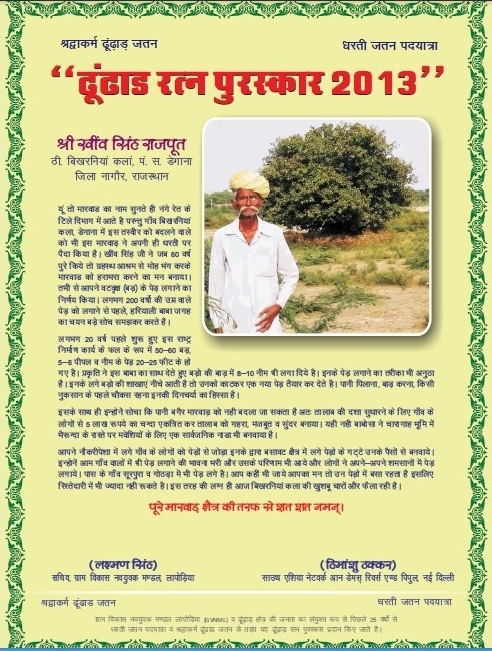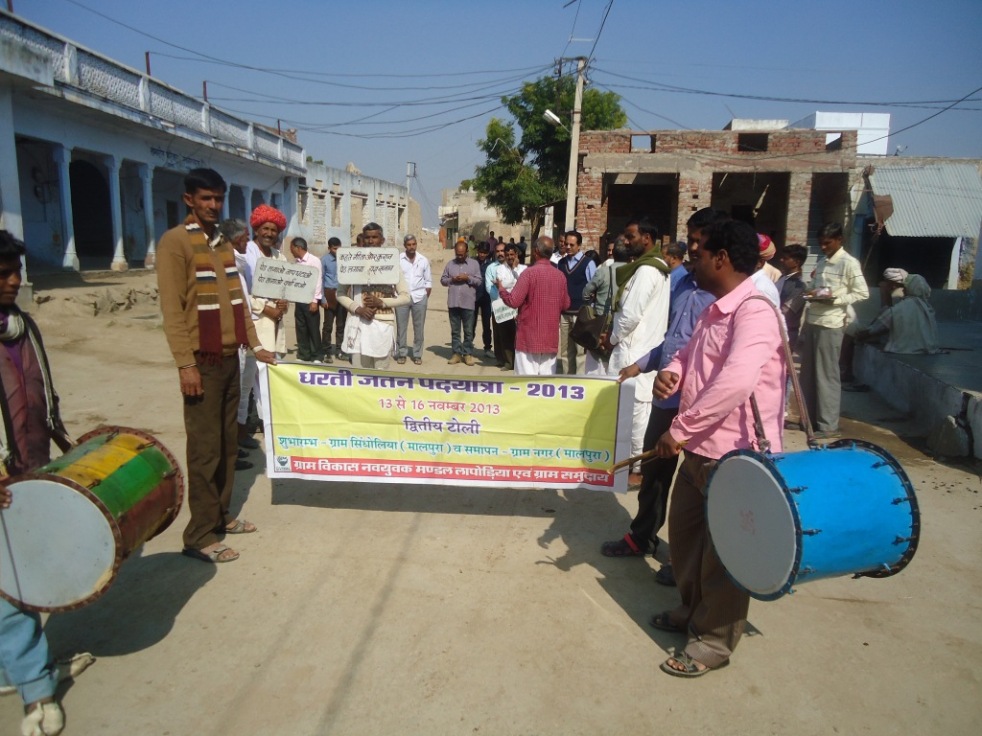It was certainly a Conference of Party (COP) of sorts. Those present included farmers, women, academics, media persons, delegates from other states (Gujarat, Madhya Pradesh, Uttar Pradesh, Delhi), Non Government Organisations and elected representatives. It also happens to be an annual event that has been going on for 27 years. It was certainly celebrating the work that actually helped mitigation and adaptation in changing climate in both drought and flood related possibilities. It was also happening on the same dates as the COP 19 was going on far away in Warsaw, Poland.

It was an honour for me to be present at Nagar village in Malpura block in Tonk district in Rajasthan at the 27th annual Dharati Jatan conference where the Pad Yatra from two different streams that culminated. Five eco warriors were honoured at this meeting with a certificate, silver medal, shawl and other ceremonial gifts. They were being honoured for their work related to tree plantation, soil and water conservation and protection of grazing land.
As speakers at the conference on November 16, 2013 narrated, this annual festival is a remarkable achievement by the Gram Vikas Nav Yuvak Mandal at Laporiya in Dudu block in Jaipur district, led by Laxman Singh, now famous for his grazing land protection through the unique chauka system.

Experience of the marchers The leaders of two streams of marchers presented their experience. Rameshbhai Saini, leader of the first stream that marched through the 15 villages of Dudu block (Jaipur district) also mentioned the difficulties people are facing. For example, he mentioned how Phulsagar, one of the tanks in Laporia is encroached and communities’ efforts to remove the encroachment did not succeed as the encroacher had the support of the Rajasthan minister Babulal Nagaur who is also the member of the Legislative assembly from the local area.
Ramjilalji, the leader of the second stream that walked through Malpura block villages (Tonk district) starting from Sindolia village, also said that encroachments on tanks are increasing under political support and when volunteers try to remove such encroachments to save the water bodies, they are faced with court cases. He also said that the state government is laying long distance pipelines and building cement containers to bring the water from mega dam Bisalpur to the villages in the area. He very pertinently asked, will we allow our water harvesting culture to be destroyed since now we have this piped water supply? Reflecting unconvincingly on this dilemma, the letter from state government’s principle secretary Purushottam Agarwal (he was supposed to come for the function, but had to travel elsewhere due to some family emergency and hence sent a letter) suggested that the pipelines are only for drinking water and tanks that the GVNML has helped build are for irrigation and other purposes. The fact is that the state government made no effort to consult the people before coming up with the pipeline scheme. Kesarbhai, active in Mahoba district in Uttar Pradesh described the Apna Talab Abhiyaan through which already 70 talabs (tanks built with earthen bunds) have been built in less than a year.
Participants from other states Pankaj Shrivastava from Mahoba appreciated that communities in GVNML area have system of imposing fines when anyone is caught polluting the lakes (as reflected in the wall writing in the photo below at the Nagar village tank).

He also said that the communities in their area is trying to clean up Kiratsagar lake in Mahoba through a focused campaign since Oct 5, 2013. Mavjibhai from Vivekanand Research & Training Institute, Bhuj (Kutch in Gujarat) said that they plan to take up implementation of chauka system in 55 villages along the 60 km long Rukmawati river in their area.
The Awards The five awards presented on this occasion were indeed very well deserved ones. The managing committee of Akodiya village (Dist Ajmer) was recognised for the tradition of collective management of common property resources including grazing land and water harvesting systems.

Rajjak Sheikh of village Tikel (Block Dudu in Jaipur district) was honoured for planting long living trees like peepal, Banyan, neem and other local varieties along the tank embankment over the last five years through his own efforts. He also got the fisheries contract given for the village tank canceled and got some of the hunters caught at his own personal risk.

Next, Shravanlal Jaat, a shepherd of village Kalyanpura (Dudu, Jaipur) was given the Dhudhad Ratan prize for consistently planting large number of trees in grazing land and along the village tank with his own personal effort and expenses for more than five years and also taking care of the planted trees.

Efforts of Umrao Godha, a relatively rich man of village Jhirota in Ajmer district were recognised for transforming the village with institutions like school, health centre and also for planting and taking care of large number of villages. Enthused villagers elected him as village head.

Khivsingh Rajput, an old man of Bikhraniya Kalan village from relatively far off Nagaur district (Marwad area) was also honoured for his 20 year old campaign in the village to plant long living Banyan and other trees in very dry area. He also inspired people to donate money and collected Rs 5 lakhs to deepen, renovate and strengthen the village tank.

Relevance for climate change The work of GVNML in the region is remarkable in many respects. The water conservation work helps recharge the groundwater and this water is then available in years of deficit rainfall, the frequency of which is bound to increasing in warming climate. Similarly, the whole area has created such a remarkable water conservation system that even when rainfall is excessive, this area will not face any floods since the water will be stored and only slowly released. The soil here has increased carbon content which also helps hold the moisture much longer, thus helping overcome the dry spells which has also increased in recent years. Thus it is clear that the that is underway over the last over three decades under GVNML has huge implications in the climate change context. The COP 19 talks at Warsaw remains deadlocked, waiting for some façade to emerge to show progress, this different COP 27 at Nagar shows so much progress is possible when the communities are at the helm of the affairs. It is doubtful though that the lessons from COP 27 at Nagar will have any impact on COP 19 at far away Warsaw.
Himanshu Thakkar (ht.sandrp@gmail.com)

What lovely message, Thanks Himanshu Jee.
LikeLike
This is the kind of news that keeps hope alive.
LikeLike